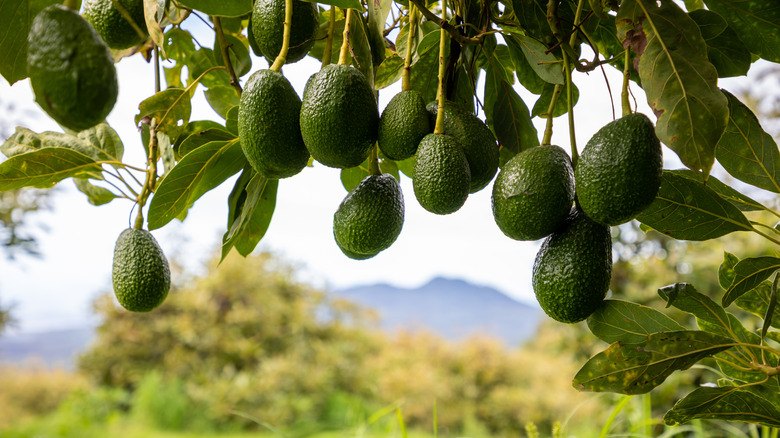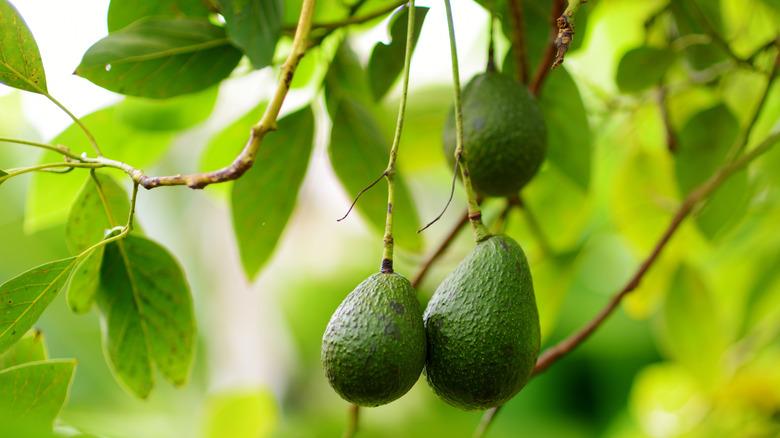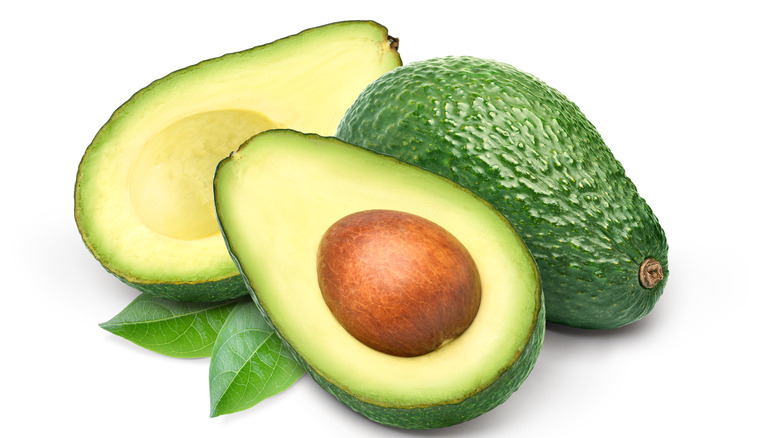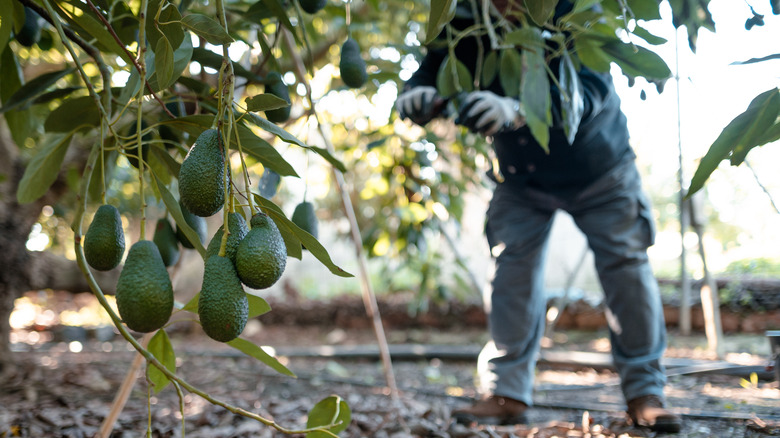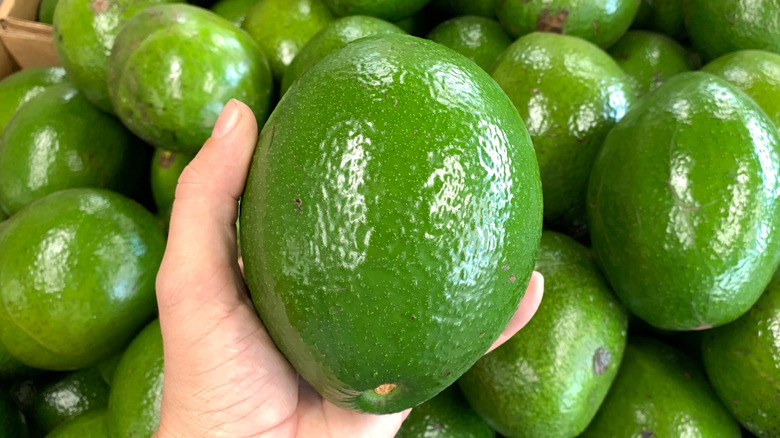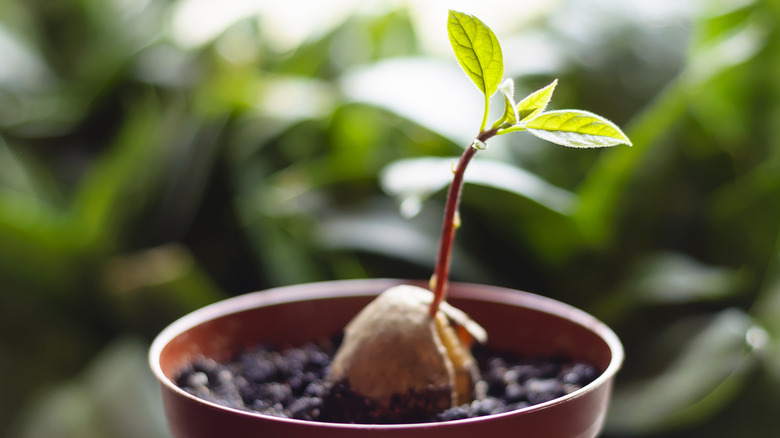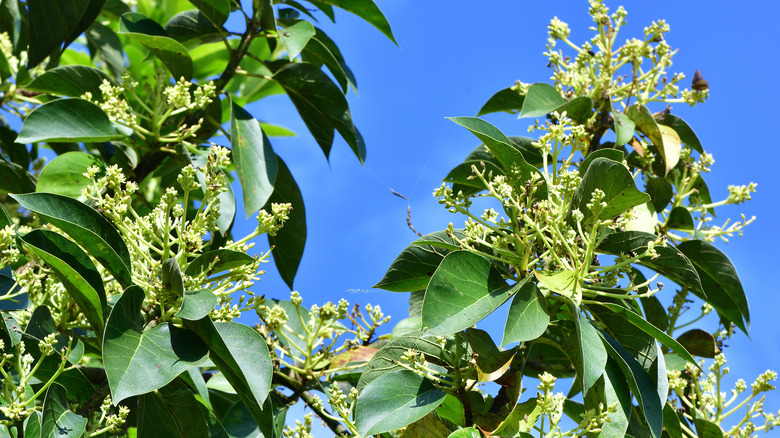How To Grow And Care For An Avocado Tree
Avocados are a versatile, beloved fruit because of their fresh, creamy texture and taste. They're made into guacamole, mashed onto toast, or included in salads and smoothies. Originating in south-central Mexico between approximately 7,000 and 5000 B.C., the avocado (Persea Americana) is actually a fruit (not a vegetable); it is also one of the most uncommon fruits that contain unsaturated fats, according to Harvard Health Publishing. By the early 1870s, Judge R.B. Ord of Santa Barbara presented avocados to the U.S. by transporting avocado trees from Mexico. During the 1920s, the well-known California Hass avocado tree was developed by farmer Rudolf Hass, although the exact origin of the seeds is a mystery. With the avocado's commercial potential, 25 varieties were originally developed in the early 20th century, per the California Avocados. From the 1950s and beyond, California has become the favorite in domestic avocado production.
Why plant an avocado tree? Avocados are healthy and contain fats that help lower unwanted LDL cholesterol. If you're seeking the benefits of cultivating your own supply, growing avocado trees can be a challenging experience, especially starting with a pit, as it might take between 8 to 10 years to bear fruit. Although, grafting takes as little as two to three years, which is the common commercial process. They can grow up to 40 feet or more with oblong-shaped leaves the size of your hand.
Read on to learn more about how to grow and care for an avocado tree.
How to use an avocado tree in the garden
Avocado trees grow quite tall, well over 20 feet, so deciding where to plant one in your garden is essential. With a domineering root system, the tropical evergreen should be planted at least 30 feet away from your home or other buildings, including other plant life within the area, per Hunker. Planting other plants and trees too close may also lead to stunted growth of your tree. During its establishment, make sure the ground is warm enough for your young avocado tree and place it in a spot that receives the fullness of the sun.
With placement, think about what other plant life might be affected by the tree's growth and size over time. It may also create too much shade for the other members of your garden. According to Yard & Garden Guru, some complimentary vegetation to plant nearby might be comfrey, lemon balm, lemongrass, leeks, onions, and mint. Flowers and herbs (lavender and rosemary) are a wonderful addition to plant a bit further away from the new growth, as they will administer in the pollination process. Additionally, make sure the ground is sufficient for your avocado tree by testing the nutrient levels of your soil with a simple test kit. This will help determine the natural levels in the ground and catch potential deficiency issues, per Happy Sprout.
How to grow an avocado tree
Typically grown in warm, tropical climates, avocado trees can be cold hardy but thrive best in hardiness zones 8 to 11. Overall, they like a temperate climate without too much heat or snow, per Hunker. Growing an avocado tree from a seed is a unique process, as you can produce one from the actual pit of the fruit. Begin by poking a toothpick through the center of the seed until it's about a ¼ to ½ an inch in. Then, suspend the bulb in a glass or jar filled with water an inch in depth. Place it somewhere with plenty of indirect sunlight until you see roots emerge from the bottom; a small seedling should sprout on top. Once the seedling is 6 to 7 inches long, cut the stem in half (about 3 inches in length). Transfer it to a 10-inch pot after more growth exists. Keep the soil moist but not saturated. If the leaves appear yellow, it's receiving too much water.
Planting a young avocado tree is a different process. Make sure to plant anytime from March to June; the summer's heat is too much for it to get established. Dig your hole as deep as the root ball and twice as wide with extra room to work with. The avocado has a delicate, shallow-rooted ball, so give it proper ventilation. Begin watering two to three times a week, then once a week after the first year of maturation.
How to care for an avocado tree
If you want a tall, sturdy avocado tree, it's important to care for it properly. For outdoor areas, avocados like loose, rich, well-drained soil. Freshly planted trees need watering two to three times a week within that first year. Once established, give it deep drinks under its canopy, allowing it to dry before watering again. During the summer months, mature trees require approximately 2 inches of rain or irrigation weekly. Trees may vary but pruning your avocado tree should be a regular activity, as it is vital for its level of growth. Prune horizontal branches that are low from the ground. According to California Avocado Commission, you can also cut windows in the canopy to allow more light inside the tree. Each time it grows 6 inches tall, cut back two sections of leaves from the top. Keep your tools clean and dispose of any infected clippings.
What about fertilizer? Avocado trees thrive in soil with a pH between 6 and 6.5. If your tree appears weak, it may be time to add some fertilizer. Try a citrus tree fertilizer or organic compost. In addition, they love receiving various nutrients, including micronutrients, which help maintain their vitality. The two main ones are nitrogen and zinc. Nitrogen assists with its general growth and development and zinc with its fruit development, per Gardening Know How. During the summer, you can apply a nitrogen-rich fertilizer on a weekly basis.
Varieties of avocado trees
With similar pear-like shapes and rough green skins, there are over 500 types of avocados that are cultivated around the world. They are categorized as either an A-type or B-type cultivar. With so many hybrids in existence, most have originated from Guatemala, Mexico, and the West Indies. Here are the top five avocado fruits we know today:
- Hass (California) – Hass is the most popular fruit which is produced and available annually. With a dark green, pebbled skin, this avocado is creamy with a nutty flavor.
- Choquette "slimcado" (South Florida) – This unique avocado is abundant in size with a watery texture and yellow-colored flesh. The skin is smooth and shiny and tastes earthy and fresh with less fat and calories.
- Gwen – Comparable to the California Hass, these lovely avocados are slightly larger and plump with a similar pebbled texture, a greenish-gold interior, and smaller seed.
- Pinkerton – These were first grown by the Pinkerton brothers in Saticoy, California. They have an elongated body shape and are known for their high oil content, which adds a classic avocado flavor.
- Wurtz "littlecado" (dwarf) – This is the top dwarf variety to grow in large containers or included in small landscapes. Grows only 8 to 10 feet tall and bears fruit within a few years of being grafted, per Louie's Nursery.
Are avocado trees toxic?
Although the flesh of an avocado is edible for most humans, it's important to be aware of the potential risks that an avocado tree can have on your pets and farm animals, according to ASPCA. Several parts of the tree contain a fungicidal toxin called persin, which is found in the bark, leaves, fruit, and pit. Diarrhea and vomiting may occur in dogs, as well as more severe symptoms in a variety of animals. Birds may feel weakness and depression and even suffer cardiovascular damage or death. Other farm animals like horses, donkeys, goats, and sheep have been known to get swollen heads and necks (edematous).
Avocados are also high in histamine, so an oral allergy is possible for humans. For some, this may happen when eating or touching the fruit triggering symptoms of itchy lips, mouth, or throat. Fortunately, the leaves of the avocado tree offer many health benefits to us, including high quercetin levels (allergy-fighting), calcium, magnesium, potassium, and zinc, per The Avo Tree. By making tea from the leaves, your body will also benefit from the antioxidants, fiber, minerals, and protein. This wholeness can promote a heart-healthy life by lowering blood pressure and reducing hypertension.
How to repot an avocado tree
Avocado trees can be houseplants (often dwarf varieties). Choose a pot or planter that is just a few inches bigger than its original one, both in-depth and in diameter. Use garden soil rather than potting soil for plenty of aeration for the roots. If you decide to move your container outside, keep it well hydrated, especially during summer. If the temperature drops below 50 degrees Fahrenheit, it's time to bring it back inside, per Pennington.
Knowing the right time to repot your avocado tree is part of the process. The best time to check if your avocado is rootbound is spring. Whether you started it from a seed or a small plant, you can do this by examining the root ball's progression within the initial pot. Remove the plant gently by squeezing the bottom with one hand and tipping it over into your other hand; you might also try rolling the pot carefully on the ground to loosen it up. According to Gardening Know How, it's ready to transfer when the base appears rootbound or when the growth of the roots is dominating the soil. Look over the roots and remove any pieces that are withering or dead.
How many avocado trees are needed to produce fruit?
Planting an avocado tree solo in hopes it will bear fruit right away may be more ambitious than you think. There are a few factors behind this. Avocado trees that are grafted seem to grow fruit well, as they often show results within three to four years. Non-grafted trees can take up to 7 to 10. Thus, avocado trees should be a mature grafted variety in order to produce fruit abundantly, according to Gardening Know How. Other reasons for a lack of fruit might be if you live in a chilly, non-tropical climate. Additionally, avocado trees possess a unique flowering behavior called protogynous dichogamy, which involves a healthy function between the male and female parts in each flower.
For better ripening results, planting two trees is necessary. They will thrive in sandy loam soil with lots of sun. Avocado trees that grow together produce together. More specifically, both types of the tree's flower are responsive to pollination, as the tree will establish avocado growth when types A and B work together, per SF Gate. With success, fruit production occurs every other year. Age also has something to do with it. A tree that is started from a pit needs at least 10 to 15 years before it can produce avocados. Once your avocados appear a pale to dark green, they are ready for picking.
